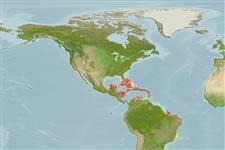>
Ophidiiformes (Cusk eels) >
Dinematichthyidae (Viviparous brotula)
Etymology: Ogilbichthys: Named for the great Australian ichthyologist, J. Douglas Ogilby.; longimanus: Named for the long pectoral fins which are longer than in any other American dinematichthyine..
More on authors: Møller, Schwarzhans & Nielsen.
Environment: milieu / climate zone / depth range / distribution range
पारिस्थितिकी
समुद्री प्रवाल-भित्ति संयुक्त; गहराई सीमा 0 - 15 m (Ref. 55786). Tropical
Western Central Atlantic: off Cayman Islands, Bahamas and Haiti.
आकार / वज़न / Age
Maturity: Lm ? range ? - ? cm
Max length : 7.3 cm SL (female)
Short description
पहचान कुंजी | आकृति विज्ञान | मौरफोमैटरिक्स
पृष्ठीय सौफट रेज़ (सम्पूर्ण) : 70 - 79; ऐनल सौफट रेज़: 55 - 64; जानवरों की रीड़ का जोड़: 40 - 43. This species is characterized by the following: pectoral fins long (16.7-20.3% SL); soft interorbital broad (7-9.4%SL); pectoral distance long (33.2-37.4%SL); elongate neural spines 4; rows of large scales on lower cheeks 3; outer pseudoclasper a broad, rounded lobe; fleshy isthmus between pseudoclaspers wide; anterior inner pseudoclasper submerged in pocket of isthmus; otolith with fused colliculi (Ref. 55786).
Life cycle and mating behavior
Maturities | पुनरुत्पत्ति | Spawnings | Egg(s) | Fecundities | लार्वा
Møller, P.R., W. Schwarzhans and J.G. Nielsen, 2004. Review of the American Dinematichthyini (Teleostei, Bythitidae). Part I. Dinematichthys, Gunterichthys, Typhliasina and two new genera. aqua, J. Ichthyol. Aquat. Biol. 8(4):141-192. (Ref. 55786)
IUCN Red List Status (Ref. 130435)
Threat to humans
Harmless
Human uses
साधन
Special reports
Download XML
इंटरनेट स्रोत
Estimates based on models
Preferred temperature (Ref.
123201): 26.5 - 28.1, mean 27.5 °C (based on 409 cells).
Phylogenetic diversity index (Ref.
82804): PD
50 = 0.5078 [Uniqueness, from 0.5 = low to 2.0 = high].
Bayesian length-weight: a=0.01000 (0.00244 - 0.04107), b=3.04 (2.81 - 3.27), in cm total length, based on all LWR estimates for this body shape (Ref.
93245).
Trophic level (Ref.
69278): 3.3 ±0.5 se; based on size and trophs of closest relatives
Fishing Vulnerability (Ref.
59153): Low vulnerability (10 of 100).
